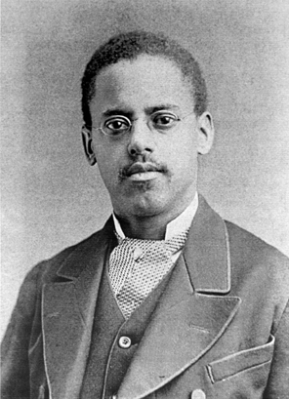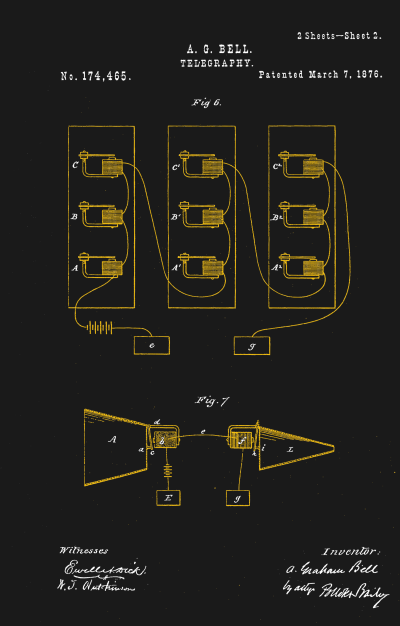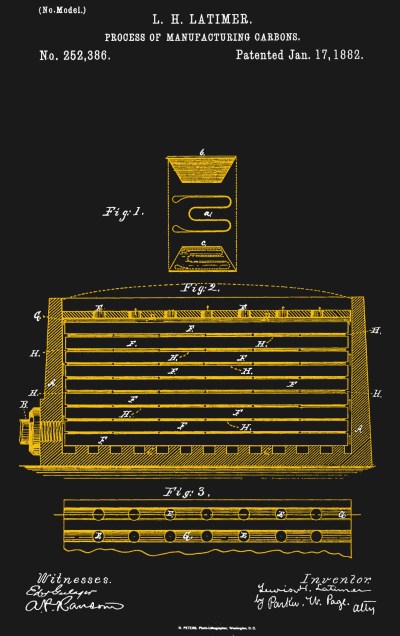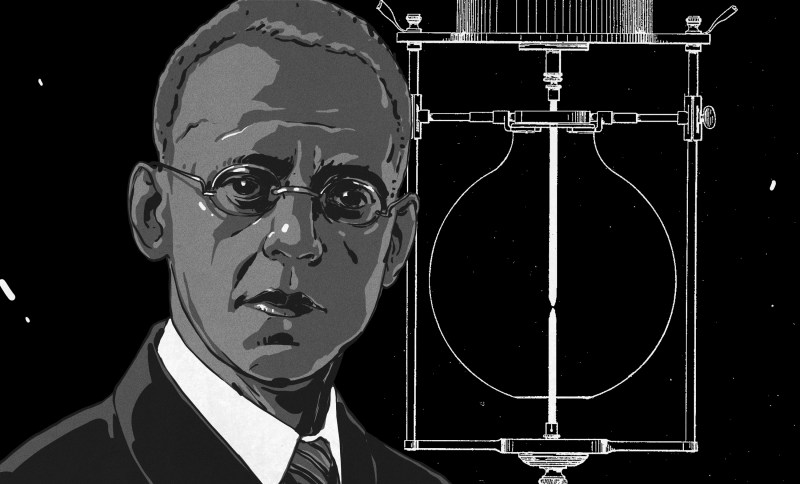These days, we have LED light bulbs that will last a decade. But it wasn’t so long ago that incandescent lamps were all we had, and they burned out after several months. Thomas Edison’s early light bulbs used bamboo filaments that burned out very quickly. An inventor and draftsman named Lewis Latimer improved Edison’s filament by encasing it in cardboard, earning himself a patent the process.
Lewis had a hard early life, but he succeeded in spite of the odds and his lack of formal education. He was a respected draftsman who earned several patents and worked directly with Alexander Graham Bell and Thomas Edison. Although Lewis didn’t invent the light bulb, he definitely made it better and longer-lasting.

Born Free
Lewis Howard Latimer was born September 4th, 1848 in Chelsea, Massachusetts, near Boston. He was the youngest of four children. Lewis’ parents, George and Rebecca, had been slaves in Virginia, but Lewis was born in free territory.
Eight years before Lewis was born, his parents escaped to the north on a steamer, but George was captured in 1842 when someone who knew his former owner spotted him on the street. His plight caught the attention of abolitionist leaders who raised money from the citizens of Boston to purchase George’s freedom. By this time, Rebecca was pregnant with George junior.
In Chelsea, George worked as a wallpaper-hanger and also owned a barbershop. Lewis helped his father with both until George disappeared when Lewis was 10 years old. The Emancipation Proclamation was still a few years away, and it is thought that he was tired of worrying about being recaptured and went underground.
At 13, Lewis got a job as an office boy in an attorney’s office. He lied about his age and joined the Union Navy at age 15, but was honorably discharged about a year later. He helped his mother clean houses for a while, and then found out that the patent office of Crosby & Gregory was looking for a boy with a taste for drawing. Lewis had always liked drawing and jumped at the opportunity.

Drafting the Future
At Crosby & Gregory, Lewis provided a constant shadow for the company’s draftsman whenever he could spare a second between office duties. He soon bought a set of secondhand tools and books, and practiced technical drawing in his spare time. Eventually, the draftsman let him do some sample drafting. They were impressed with Lewis’ skills, and when the draftsman resigned, Lewis got the job.
Drafting patents requires that the artist and the inventor work closely together. Because of this, Lewis learned about a lot of things and was well-versed in the the technical and legal aspects of patents by the 1870s. Lewis applied for his own patent for the first time in 1874 — an improvement for water closets in railroad cars. It was deemed too insignificant for a patent.
In the mid-1870s, his firm was working on patents for Alexander Graham Bell’s telephone, and Lewis Latimer was drafting all the technical drawings. In keeping with the lore about Bell’s work and sleep habits, legend has it that Lewis had to wait until after 9PM each night for Bell to be available to give him his instructions.
Lewis left Crosby & Gregory in 1878 because of management changes. During this time he worked a few jobs slinging wallpaper paste like his father before him and relocated with his wife Mary Wilson (whom he wed in 1873) and two daughters to Bridgeport, Connecticut where his sister lived. There he would eventually land a drafting job at Fallandsbee Machine Shop.
The Draw of Electric Light
After Thomas Edison received a patent for the light bulb in 1879, electric lighting began to quickly taking over gas lighting. Historians suggest that Lewis had become enamored by electric light and believed it was the future. It was certainly in his future.
One day, Hiram Maxim, owner of the United States Electric Lighting Company strolled into the machine shop. He saw Lewis sitting there drafting and was intrigued. Maxim asked him a bunch of questions and by the end of the conversation, he’d hired Lewis as his draftsman and general assistant.

Lewis started at the two-year-old company in 1880. Maxim was trying to make light bulbs, the hot new gadget of the times. He and his partner William Sawyer had incandescent lamp patents, and theirs was only the second to market after Edison’s.
Maxim’s process for treating filaments included a hydrocarbon vapor that equalized and standardized resistance. It also made them burn longer than the Edison filaments, which were made of bamboo. Lewis perfected a way to produce these filaments without breaking, as they were prone to do. He suggested using a material with the same rates of expansion and contraction as the filament blanks. Lewis received a patent for this method in 1882.
Although U.S. Electric’s lamps had a longer-lasting filament, they didn’t beat Edison because they didn’t have the scientific method down, doing mostly guesswork instead. While US Electrical focused on a quality lamp, Edison wanted complete vertical integration of the electrical world from the filament to the dynamo.
Like many 1880s startups, U.S.Electric was one among many small companies vying for light bulb market share. Lewis was terribly important to the operation and likely the only draftsman that Maxim had and his value extended far beyond the drawing table. He had the great responsibility of overseeing lighting installations, which requires a lot of knowledge. In 1881, Lewis became superintendent of the incandescent lamp department, overseeing 40 workers.
Around this time, U.S. Electric merged with Weston Electric. Lewis was sent to England to oversee a large lighting installation. Although the workers didn’t care to take orders from a black man at first, he eventually won them over. When his contract was up in England, he and Mary moved back to the States, but there was no job to come back to. He moved from company to company for a while and wound up at Olmstead Electrical in Brooklyn as draftsman and manager of lamp fabrication. Lewis convinced them to manufacture his lamp, but it never received a patent and wasn’t commercially successful.

Edison’s Pioneers
In 1884, Lewis was hired by the Edison company to be their chief draftsman and expert witness as to the facts as they related to the early stages of the electric light business. In other words, he helped Edison prosecute patent infringers. The only suit that went anywhere was the one against Lewis’ old company, U.S. Electrical, which Edison won. In 1889, Lewis joined the Edison legal department, though he still had drafting duties.
General Electric was created when Thomson-Houston and Edison Electrical merged on April 15, 1892. Westinghouse remained heir biggest competitor. By 1896, there were 300+ lawsuits pending between the GE and Westinghouse. They finally reached an agreement in 1896 and pooled the bulk of their patents, with GE retaining their own incandescent lamp patents.
Lewis was asked to join the Edison Pioneers, a group of twenty-eight men who had been integral to the development of the light bulb up to and including 1885. He was bestowed this honor despite never working in Edison’s laboratory itself, and was the only African-American member. In 1890, Lewis published Incandescent Electric Lighting, a practical description of the Edison system.
Lewis died December 11, 1928 after a lengthy illness. He was 80 years old.















“But it wasn’t so long ago that incandescent lamps were all we had, and they burned out after several months. ”
No mention of the fixing and gouging the light bulb companies all did because their bulbs were lasting TOO long? They made a deal that no member of their group could have a bulb that lasted more than 1000 hours. It’s a neat story.
Wasn’t that deal worked out in the 1930s?
Incandescent lamps were never all we had. The carbon arc lamp was invented in 1805.
OK then, the only practical home lamps we had?
You also had the limelight, which was heating up a piece of calcium oxide with an oxy-hydrogen torch until it glows white. The gas was generated by electricity.
>because their bulbs were lasting TOO long
The real story about the bulb conspiracy is that some manufacturers were making false claims about the longevity of their bulbs, while others were using longer filaments (lower efficiency) to make bulbs which would burn dimmer and last longer. Nobody had much quality control, so some bulbs would burn out in a week while others would burn for a decade. Ordinary consumers had no way of checking or measuring the power consumption of a bulb, so they had to trust the manufacturers when they said a bulb was 60 Watts or that it lasted 2,500 hours. Of course they all cheated and the whole thing became a lemon market: consumers wouldn’t trust the claims and would refuse to pay anything more than the minimum price, so the lowest quality bulbs won the market.
This was at the point when the tungsten filament bulb was entering the market. The carbon filament bulbs had reached their technical limits in terms of brightness and lifespan, so the only competition to the tungsten filament bulb was the tantalum wire bulb which was dimmer and more fragile. Because of the lemon market effect, the tungsten filament bulbs were becoming only marginally better in a race to the bottom. Doing that, they would have lost market share even to the cheaper carbon filament bulbs and gas lighting, because people would not find the small difference important enough. That’s when the “conspiracy” set in to standardize the lifespan of the bulb to 1,000 hours, which effectively fixed the actual light output per Watt and provided a superior light to all the other competing technologies.
The same lemon market effect is working today. For example: you can make LED bulbs which offer nearly perfect color rendering compared to compact fluorescent lights, but since the superior incandescent bulb is now banned, there is no competition, because consumers can’t compare. All the LED lamp offerings have the same 80-82 color rendering index value as the detested curly tube lamps, because they don’t need to be any better than the closest competition. Since consumers can’t readily measure the spectrum of the light or the true light output, the producers are regularly caught selling substandard products with false numbers printed on the package.
Thank you for clarifying the “light bulb conspiracy” myth. Too many poeple only understand “artificially limit the lifespan” but not the natural relationship between temperature, efficiency and lifespan.
And quality control. You can claim anything you want, but if you don’t actually test your bulbs then your claims are worth nothing. The Phoebus cartel mandated that the bulbs were actually tested, and fined their members for going significantly over or under the limit, which forced the manufacturers to develop consistent manufacturing processes.
After all, it was the entire industry’s reputation at stake. The cheaper manufacturers would just wing it and stuff all the bad bulbs with the good ones, so the consumers would always expect to get a few “duds” and not pay a proper price for properly made ones.
That’s where the expression “not the brightest bulb in the box” comes from. They really were noticeably different.
The LED might last a decade but the driver will not.
If you open the driver, and add the input and output filter capacitors that where “cost optimized” they last much longer… And it gets rid of the annoying line frequency flicker.
The LED won’t last for ten years. The “drivers” in LED bulbs are often nothing more than a capacitive dropper. Unregulated, and vulnerable to any variation or surge of the AC voltage.
Not to mention the crummy connections. The wires connecting the driver to the socket are not soldered or crimped or spot welded. They are clamped between the thin sheet metal of the base and the (squishy) plastic of the bulb. They develop loose connections and blink.
The only reason for blinking I know is insufficient cooling of the LED chip, so the bondwire dislodges and it fails/blinks. The – while not very good – crimped connection to the base is rarely a problem, as the current is quite low.
Have done safety type tests and EMC tests and HALT and other such stuff on commercial and consumer LED stuff. Most of the consumer-grade stuff made over 5 years past will probably not last 10 years (63 percentile failure rate); and industrial lighting systems from same era will probably be ok for 11 years. But considering that industrial grade stuff is rated for higher hours per day, the consumer-grade stuff will have an order of magnitude greater failure rates for equivalent operating conditions.
Stuff made recently may or may not be more reliable, but even if consumer-grade stuff lasts for 10 years, its CRI will suck.
As others did mention. the incandescent bulbs have long been rigged for (very) finite lifetimes (see the NYFD light that never burns out). Consumer LED replacement bulbs are similarly rigged for the same fate via their feeble drivers.
That’s why I keep my receipt for the LED bulbs and bring their junk back when it dies.
That story.
https://www.snopes.com/fact-check/watt-a-lightbulb/
Light bulb conspiracy.
https://conspiracy.fandom.com/wiki/Light_bulb_conspiracy
The bulb is in California and has lasted so long because it’s been run on just enough voltage to make it barely glow for most of it’s existence. https://en.wikipedia.org/wiki/Centennial_Light
That’s just how I like my illumination: barely visible.
I prefer brilliant light, often 4000K or 6000K. Ok, there are some occasions where a dim light is more comfortable. But they are rare.
Biologically speaking, most indoor lighting is “dim”. You start to lose color vision with a daylight bulb under normal room lighting levels – they’re really only useful when you triple the usual amount of light as in an office or a factory.
Yes, but the important bit that was glossed over was his train toilet patent.
https://patents.google.com/patent/US147363A/en
They previously just had open holes which apparently let in not only a draft, but also kicked up debris from the track made it up to the users behind, so people weren’t using the toilets in general (no concern seems to have been had for the dumping of waste directly onto the track). His idea was to have a door which closed when you opened the lid, and released when you closed it again.
May still be used.
https://en.wikipedia.org/wiki/Passenger_train_toilet
I’ve seen tomatoes growing in the tracks at my local station, due to “debris” left from flushing the toilet whilst the train is in the station.
Commuter coaches of the Central Railroad of New Jersey had toilets which consisted of a wooden box with a hole and a seat on top and a bottom open to the air were still being used in the early 1980s.
I’d like to know who made the designs documented by the drawings – is this and the design process somehow documented? This would be a good idea for an article – how did they work during this period at places like Edison’s company?
We know about the famous and genius ideas of Edison, Tesla and Bell – but how did they brought these ideas into mass production? How did they handle the design cycle?
Very interesting story, thanks a lot! I imagine this was a lot of work, also.
I’d only like to add that modern LEDs still have a long way to go.
They are much better than these pesky energy savings lamps of ~15 years ago,
but light quality is still not on par with light bulbs.
Light bulbs, maybe in halogen form even, do produce a warm, natural light (no peaks in spectrum). LED bulbs do produce blue light, which is said to be very bad for the eyes (please don’t use an alarm clock with bright blue display).
While the blue is filtered by milky toned plastic I do still worry about the long term effects on humans or animals (pets).
Here is a good comparison of the power density spectra of a white LED and a classic light bulb.
https://www.researchgate.net/figure/A-comparison-of-the-power-spectrum-of-a-standard-white-light-LED-a-tricolor-fluorescent_fig1_303682799
There may be remaining UV radiation not “consumed” by the fluorescence but it is claimed that this UV radiation will be blocked by the plastic casing.
But even in the visible domain the blue light may be harmful:
https://health.clevelandclinic.org/are-led-lights-damaging-your-retina/
And as far as I know divers prefer halogen lamps over LED lamps because the more “flat” spectrum shows the color of the fishes better.
In low light conditions, we need “warmer” lights to see and distinguish color properly. This is called the Purkinje effect or the Purkinje shift in the color response of the eye depending on lighting levels. As the light levels drop, our eyes expect to see a color temperature resembling a sunset and correct accordingly by reducing their sensitivity to red light. This happens at lighting levels below about 300 lux.
Unless you plan on having 1,000 lux office lighting in your living room, “daylight” (7000K) bulbs will essentially turn you colorblind. Real indirect daylight is 10,000 lux, while your living room in the evening is typically around 75 lux, so it requires yellow-red light for you to see properly.
There’s also a second effect where the eye responds to the amount of blue light to decide how bright it is, so when you shine a dim blue light at your eye, it decides it’s brighter and narrows the iris, which allows even less light in. It feels as if you’re peering into a bright light, but actually you see less. The modern habit of using blue-yellow LEDs for streetlights, bike lights, and even car headlights makes them appear very bright, but you really can’t see s*** with them because all the browns and red hues of the ground appear almost black. All they do is kill your night vision.
Philips did make a CRI=99 bulb with a light output actually equivalent to a 60 Watt halogen bulb to win the L-prize, but they discontinued it after collecting the brownie points. It was too good to be sold – and too expensive.
The trick is that achieving higher color rendering index eats away at the nominal efficiency. That’s because lumens are measured by the human standard color response – you get more lumens out of the same wattage by screwing around with the spectrum and concentrating the power on the wavelengths which we perceive brighter. In other words, the energy-saving LED light is achieving its feat in part by producing worse quality light.
So, manufacturers can make a 6-7 Watt bulb and claim that it is “equivalent” to a 60 Watt incandescent, when it merely appears that way because of its poor color reproduction. Another part of the trick is fiddling around with what is a “60 Watt” bulb – how many lumens it makes. A real 60 Watt halogen makes between 850 – 950 lm, while the LED manufacturers claim it should be 800 lm which is 5-15% less light again.
In contrast, the Phillips L-prize bulb consumed 10 Watts for 940 lm, and it was priced at $60 per bulb.
I have a Cree downlight replacement fixture from the early days of consumer LED lighting. It looks identical to a halogen lamp, and appears to accomplish it by having red and cyan LEDs in addition to the ‘warm white’ phosphor LEDs. There’s also a color sensor to presumably keep the light constant as it ages.
Of course, Cree now mostly sells shitty 82 CRI bulbs to meet the minimum Energy Star requirement.
That was the L-prize bulb as well. It had red and UV diodes, which excited an external phosphor with a wide band green-yellow emission very much like in a fluorescent tube. It was basically a good quality cool-white fluorescent tube (CRI>87) augmented by a red diode to bring the color temperature down and fill the gap at the red end of the spectrum.
All lamp types have a specific application where they really shine (pun?). Flourescent tubes can have efficiencies over 100 lumens/w. They light up my garage in an even and great way, and were installed in the 80’s… (No, those are not 100lumens/w, I was referring to modern tubes with HF drivers). They don’t like cold temperatures in winter though. Incadescent/halogen bulbs are great if you need a good cri for your make-up mirror, or want that warm glow when dimmed. LED’s have their application too. Choose wisely and you’ll have the best lighting in all places of your home.
Good story btw.
Small piece of trivia: For those of you who are into ham radio Hiram Maxim’s (who hired Lewis Latimer to work at his company) had a son called Hiram Percy Maxim who started the ARRL. https://en.wikipedia.org/wiki/Hiram_Percy_Maxim
You can still find online Aero-Tech brand incandescent bulbs rated for 20,000 hrs of lifetime. They accomplish this by putting out about half the light of a regular consumer bulb. Their use case was things like traffic lights, where it was better to pay more for electricity than pay someone to change the bulbs more often.
These are banned for import, or you need a special license.
Import into what country?
The entire EU.
Pretty much the only incandescent lightbulbs that aren’t banned are oven lights that have to withstand 300-400 C temperatures, because no other light can. The retailers are allowed to sell their old stock, but the selection is getting thinner every year. All the traffic lights are transitioned to LEDs (with heaters to keep them dry and free of ice).
And Acetylene lamps – drip water onto calcium carbide and you get acetylene. From wiki:
“Calcium carbide was used to generate acetylene used in the lamps for portable or remote applications. It was used for miners and cavers before the widespread use of incandescent lighting; or many years later low-power/high-lumen LED lighting; and is still used by mining industries in some nations without workplace safety laws. Carbide lamps were also used extensively as headlights in early motor vehicles and as an early light source for lighthouses. “
What a cool story. Any other books or further reading about Lewis that would be recommendable? Or books in general about the historical manufacturing going on in this era?